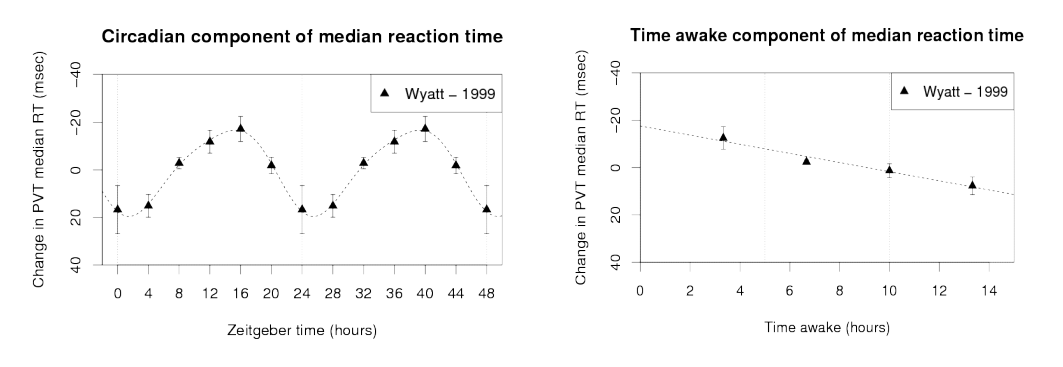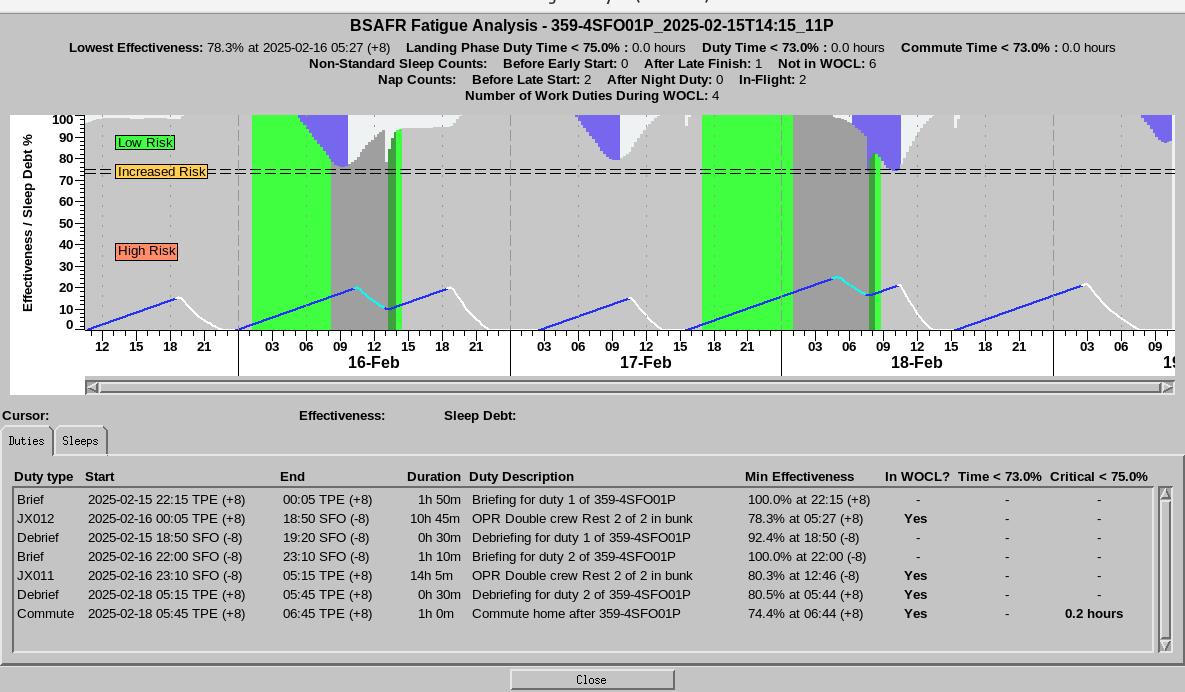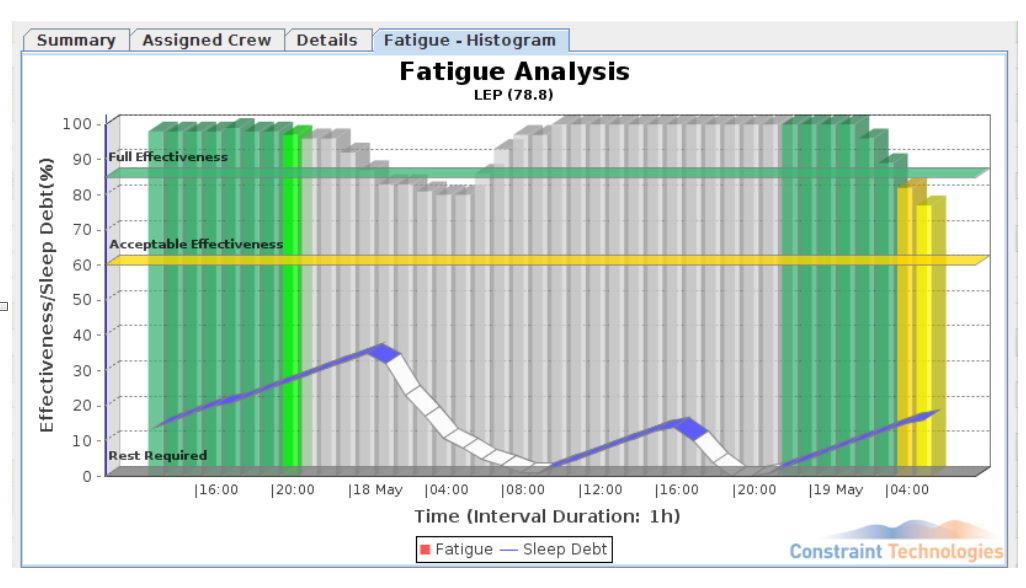In the aviation industry, ensuring the safety and well-being of flight crews is paramount. Human error can have serious consequences, and fatigue remains one of the most subtle yet significant threats to flight safety. While training, technology, and regulations all contribute to the smooth operation of flights, managing crew fatigue is crucial to maintaining high safety standards.
In this blog, we’ll discuss how crew fatigue impacts airline safety and how the BSAFR mathematical model developed by CTI has been integrated into our systems to support and enhance existing fatigue management strategies.
Understanding Crew Fatigue
Fatigue refers to a state of physical or mental exhaustion that impairs a person’s ability to perform tasks effectively. For flight crew, fatigue can manifest as diminished focus, slower reaction times, impaired decision-making, and an inability to perform duties efficiently. Factors such as extended work hours, irregular schedules, time zone changes, and high-stress environments are known to contribute to crew fatigue.
The National Sleep Foundation defines fatigue as a condition where a person is “mentally or physically impaired due to a lack of sleep or excessive workload.” Within aviation, fatigue can severely affect a crew member’s ability to perform tasks critical to flight safety, increasing the risk of errors that could compromise passenger and crew safety.
The Impact of Crew Fatigue on Airline Safety
Fatigue in aviation presents a unique challenge as it can impact all aspects of flight operations. The consequences of fatigue-related impairments can range from minor inconveniences to catastrophic outcomes. Below are some of the key ways in which fatigue directly impacts aviation safety:
1. Reduced Cognitive Function
A fatigued crew member struggles to think clearly, process information, and make decisions quickly. Cognitive functions such as memory, attention, and problem-solving are compromised, which are essential for tasks like monitoring flight instruments, evaluating weather conditions, and managing emergency situations. Even a slight decline in cognitive function can lead to delayed reactions in critical moments, potentially leading to accidents.
2. Impaired Judgment and Decision-Making
Fatigue significantly affects decision-making. Flight crews often face pressure to make split-second decisions when confronted with unexpected situations such as turbulence, technical issues, or other operational challenges. Fatigue clouds judgment, leading to misinterpretations of situations, unnecessary risks, or delays in taking appropriate action. This can increase the likelihood of accidents.
3. Slower Reaction Time
Fatigued crew members are often slower to react to changes in flight conditions. Reaction time is crucial when managing in-flight anomalies such as sudden turbulence or mechanical failures. A delay in response, even by a few seconds, can escalate a situation and potentially result in a loss of control.
4. Decreased Physical Performance
Fatigue also affects physical abilities, making it more difficult for flight crews to operate the aircraft’s controls or respond physically in emergency situations. Long hours, uncomfortable sleeping conditions, and jet lag contribute to physical exhaustion that reduces overall performance.
5. Increased Risk of Human Error
Human error is a leading cause of aviation accidents, and fatigue is one of the most significant contributors. Fatigued crew members may overlook important tasks, misinterpret information, or fail to communicate effectively with other crew members or air traffic control. Fatigue is not only a concern for pilots; cabin crew also face similar risks, affecting their ability to maintain safety and assist passengers in emergencies.
How the BSAFR Model Supports Fatigue Management
At CTI, we recognise the critical importance of effectively managing crew fatigue to ensure aviation safety. That’s why we’ve integrated the BSAFR mathematical model (Biological Sleep, Alertness, and Fatigue Risk Model) into our PegaSys systems, providing flight crew and airline management with valuable insights and real-time data to support existing fatigue management systems.
Here’s how the BSAFR model assists in managing fatigue:
1. Real-Time Fatigue Prediction and Alerts
One of the standout features of the BSAFR model within PegaSys is its ability to raise real-time fatigue alerts. Rather than being a passive system, the BSAFR model actively runs during pairing, rostering, disruption solving, and day-of-operations, providing continuous insights into crew alertness. If a crew member is at risk of fatigue due to long shifts or insufficient rest, the system generates alerts that allow management to intervene and make adjustments before fatigue becomes a safety issue.
For instance, if a crew member is forecasted to have low effectiveness during a critical phase such as landing, the system notifies the airline’s management, enabling them to adjust schedules or swap crew members as needed.
2. Predicting Sleep Opportunities to Mitigate Fatigue During Landing
The BSAFR model is highly effective at predicting sleep opportunities during flights, which can help reduce fatigue, especially during high-risk periods such as landings. By analysing a crew member’s work schedule, sleep patterns, and flight itinerary, the model forecasts the best times for in-flight rest, helping to reduce fatigue levels and improve alertness during critical phases of flight. This proactive approach ensures that flight crews are mentally prepared to perform their duties when it matters most.
3. Circadian Rhythm and Light Exposure Adjustments
The BSAFR model incorporates key factors such as circadian rhythms and predicted melatonin spikes to assess how time zone changes and light exposure will affect a crew member’s sleep and alertness. The model helps predict the impacts of jet lag and offers solutions to mitigate the effects of crossing multiple time zones, ensuring that crew members are optimally rested and ready for their duties. This is particularly important for long-haul or international flights, where crossing time zones can significantly impact crew performance.
4. Personalised Fatigue Risk Assessment
The BSAFR model goes beyond a one-size-fits-all approach. It uses individual crew data, including schedules, sleep habits, and biological factors, to assess each crew member’s fatigue risk. By personalising the assessment, PegaSys can deliver more accurate and relevant fatigue management, ensuring that specific needs are met for each crew member. This precision results in better scheduling and more effective fatigue management.
5. Improved Scheduling and Pairing
Fatigue accumulates over time, particularly during irregular schedules and long-haul flights. The BSAFR model helps airlines adjust crew pairings and rostering to minimise fatigue buildup. The system identifies pairings that could lead to high levels of fatigue and recommends adjustments to layovers or rest periods. By integrating the BSAFR model, airlines can optimise crew schedules based on scientifically-supported data rather than relying solely on work hour regulations. This leads to smarter fatigue management and a reduction in risk to flight safety
6. Fatigue Display Tools for Immediate Awareness
PegaSys integrates the BSAFR model into user-friendly visual tools, providing real-time feedback on crew effectiveness. Through visual displays, managers can easily monitor when crew members are at high risk of fatigue, particularly during critical phases such as landings. For example, the TPAC Workbench application presents effectiveness percentages, with visual indicators for landing phases and non-work periods, offering a quick overview of crew performance. Additionally, sleep debt ribbons help track recovery sleep needs, enabling managers to take immediate action where necessary.
Conclusion
Despite the stringent regulations and safety measures in place, crew fatigue remains one of the most underestimated threats to flight safety. The impacts on cognitive function, decision-making, and reaction time can have devastating consequences. At CTI, we are committed to addressing this challenge head-on with the BSAFR model, which enhances traditional fatigue management systems and provides flight crews and management with the tools they need to mitigate fatigue risks effectively.
By integrating the BSAFR mathematical model into PegaSys, we offer a proactive, data-driven approach to managing crew fatigue, ensuring that airlines can operate more safely, efficiently, and with a greater focus on the well-being of their crew members.



